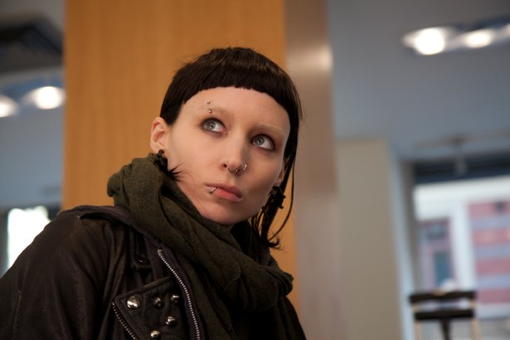By Meredith Alloway · December 23, 2011

It’s about time American audiences met a proper heroine. She’s not wearing red tights and a golden W on her bosom, but comes in more androgynous form, thin as a bone, pale as one too and as viscous as a hawk. Meet Lisbeth Salander.
Unfortunately, she’s the only force that both drives the film and lingers with you long after. Fincher agreeing to take on the second film adaption of the book The Girl With the Dragon Tattoo by Stieg Larsson, following a satisfactory version by the native Swedes, caused initial anticipation. He was on fire; still white hot after his success with The Social Network; and his cinematic skill and obvious mastering of the psychological thriller was undeniable. But initial fears about his take on the beloved novel unfortunately proved to be true: he can’t create characters with a soul.
It also must be said that Fincher had a looming task set before him: to tell a crowded, clumsy story while allowing its main players to shine through. The novel is loaded with exposition, which most every reader will agree, made reading the first half of the book as arduous as wading through a Sweden snow. The film suffered the same. But Fincher’s loyalty to the novel should be respected and Steve Zallian’s adaption admired. He delivers all the facts, key plot points and moments of insight into our fascinating protagonists Lisbeth (Rooney Mara) and Mikael (Daniel Craig).
Mikael Blomkist is a respected Swedish journalist who, after trying to reveal a corrupt business tycoon, loses his reputation and his life savings. Soon after Henrik Vanger (Christopher Plummer), a wealthy patriarch, asks him to investigate the disappearance of his niece. Harriet Vanger has been gone for forty years, and Henrik believes the killer is in the family.
Meanwhile, we follow the unusual, brooding computer hacker Lisbeth Salandar. She’s dealing with her own devils, specifically a sadistic sexual predator; Bjurman (Yorick van Wageningen) unfortunately acts as her social caretaker. We learn early on that any man who attempts to abuse her will soon face the consequences, more brutal than most could imagine. Lisbeth isn’t your normal 23-yr-old ward of the state; she’s a force to be reckoned with. Mikael soon crosses her path and takes her on as his research assistant. Together they uncover a misogynistic, sadistic and gruesome puzzle to Harriet’s whereabouts, more horrifying than they could’ve expected.
The film is a lesson in visual storytelling, with some sequences stunning in their execution. The highly controversial rape scene is done with taste (as much as it can be) and captures the terror that Lisbeth endures. It’s key in our understanding of her reaction: as horrific as Bjurman’s punishment is, it seems nothing compared to his act of abuse. When we follow her home, witnessing her limp in the snow and crouch in the shower shivering in pain, it crumbles your heart. It makes Lisbeth vulnerable, which without, she’s nothing more than a pierced angry punk.
But Fincher’s exploration into Salander’s heart is rare, and Mikael’s sense of humor non-existent. Rooney Mara though, a rookie to the screen, is impressive and her portrayal intricate. She looks more like a monster than a person, a sort-of Snow White on crack with eyes that swallow you whole. Mara wears the armor that is Lisbeth with believability, but seeing her exploration into the deeper realms of the character in the films to come is what will truly prove her abilities as an actress.
Lisbeth is most clearly the force behind the film, leaving the plot clinging to her for support. Perhaps she wouldn’t have such a weight on her slim shoulders if Fincher had given her supporting characters with a little more depth and chosen to tell the story with a little more patience. Because in the end, Steig Larsson’s characters are what gripped our hearts, not his story.